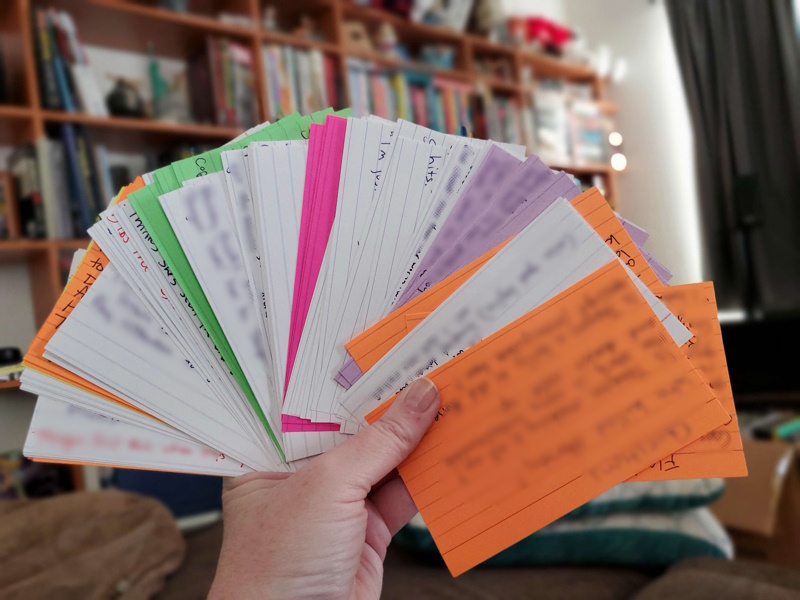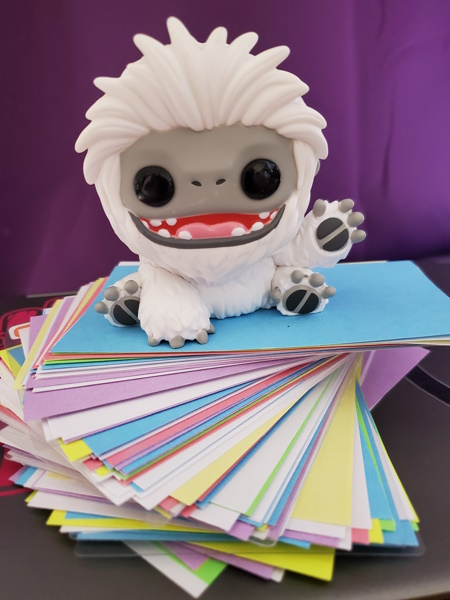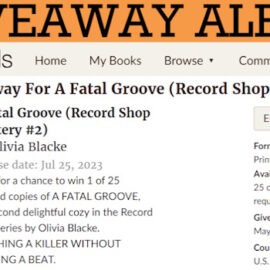Recently I was on a terrific podcast where they asked me about my writing process, and when I told them, their jaws dropped. Honestly, I never considered my process anything unusual or out of the ordinary, it just works for me. Is it overly complicated? Maybe. Are there too many steps? Probably. Does it work for me? Abso-freaking-lutely. Will it work for you? Who knows!
Step One: Inspiration
“Where do you get your ideas?” It’s a common question, and the answer is anywhere. Everywhere. Nowhere. Stories can be inspired by anything – a snippet of an overheard conversation. A glimpse of movement out of the corner of your eye. Desperation because you’ve got a book deadline looming. For this example, I’ll use the same scenario I gave on the podcast. I was at a wedding that turned out to be a total mess, the kind that would be too over-the-top for most reality TV shows. As I was waiting in the airport for my flight home, I was struck by the inspiration to write a mystery about a bridezilla killed at her own wedding.
Step Two: Scrap Paper
This next step, for me, can drag on for weeks. Month, even. Or it might only be a few hours. This is what most writers call “scribbling on bar napkins” because any nearby writing surface is fair game. I start by jotting down any ideas, no matter how incoherent, on whatever paper I can find. Sometimes it’s a clean, ruled notebook. More often, or in the case of the bridezilla story, it’s scribbling in the margins of airplane tickets and on the backs of receipts. I’ve used the notes app on my phone, but I’ve also used gum wrappers. This phase can take place on walks, while out and about with friends, shopping, watching TV, or even in an airport waiting room, but rarely ever at my desk.
Step Three: Index Cards
Once the disorganized pile of scrap paper becomes too much to manage, it’s time to break out the notecards. I use standard 3×5 notecards in a variety of colors. The colors can mean different things (or nothing at all). Green cards can be characters, important plot points, or that there were too many green cards and not enough yellow ones. If I’m working on a dual-POV, dual-timeline, or dual-plot, I might use different colors for different subplots, POVs, or timelines. This phase usually takes place on a large surface – a bed. A floor. A clean table. Using the scraps of notes I’ve written over the past however long, I start to transpose them onto cards, while elaborating and filling in the blanks. A notecard can be anything from an entire conversation to the word “Clue?”
At this point, I take all those scraps of paper (why are so many of them sticky???) and toss them in the bin.
As for the notecards? Sometimes I take a picture to post on Instagram later, often accompanied by some enigmatic clue about the story that no one but me would understand.
 |
 |
Over the next few days or weeks, I add to the cards as inspiration strikes. Here’s a snippet of a scene. There’s the motivation of a character. Here’s a red herring. And now, I start shuffling them like playing cards and putting them in a logical order. When do we meet each character? When are clues dropped and when are they finally understood? What happens to uncover the necessary information and when?
Step Four: Outline
Even if I still have gaps, I have a basic grasp of the story by now. I sit down in front of my computer and open a clean Word document and build an outline using the cards. The outline is broken up by chapters with descriptive names like “She meets the killer but doesn’t know it” and “Girl’s night out.” My outlines are Very Detailed and can include entire scenes. This is particularly helpful when I have a story in my head that needs to come out but I don’t have the time to sit down and write it. The more I can put into an outline, the better to pick it up later without losing anything.
Now that my notecards are transcribed into an outline, I don’t need them anymore. I could-and should!-toss them but often I shove them into a Ziploc bag and toss them in a box with other bags of colorful notecards never to look at them again.

Granted this is an anomaly even for me, but I once wrote an outline that was 14,363 words long. That’s novella length. Most of my outlines come out in the 3,000 to 5,000 word range.
By now, you should probably have guessed that I’m a Plotter (vs a Pantser, who literally writes by the seat of their pants). This method has three MAJOR advantages for me:
- I can juggle multiple projects at a time. I can be jotting down ideas for one story in the early stages of development while drafting another story at the same time without losing anything. And when I finally have time to sit down and write, the hard work is already done.
- I’m a traditionally published author, which means I have an agent and editor who needs a detailed synopsis before signing off on anything. Sure, I could write a 80,000 word book and hope that my editor and I are on the same page but it’s much easier to tweak a project in the early stages. I use the outline to build my synopsis and conversely, writing a synopsis often reveals gaps in my outline.
- Time. Time. Time. There’s never enough of it. I might only get a few hours to write in the evenings or on weekends and I loathe to sit in front of a keyboard chewing on my fingernails because I am trying to work out what comes next. A solid outline means I know what needs to be accomplished in this chapter or scene so I’m free to just write.
Wanna know a secret? I don’t always follow my outline. I certainly don’t follow it faithfully. My outline is essentially an early draft of a novel written in shorthand, and is often unrecognizable from the final product. More than once I’ve plotted out a mystery where the killer in the final manuscript is different than the one in the outline! Plotting and planning is no guarantee that you can’t surprise yourself with your own writing.
Step Five: Write
There are a lot of rules of writing – which may or may not actually apply to any given author or book – but there is only one rule that applies in my writing process: I do not start writing without a first line. It might sound intuitive but it took me a long time to realize this is my golden rule. A lot can change while plotting out a novel, but once I know the first line, it rarely ever wavers. I pop around a lot during the plotting steps, jumping forward and backward through chapters in the outline to add or remove action. Shuffling index cards in and out of order. Getting inspired by a scene that doesn’t come into the book until the 13th chapter.
But when I sit down to write, I write in a straight line. I don’t allow myself to go back and edit until the first draft is done. I leave myself copious notes and comments to go back and check something, to close a loop, to research or verify a fact (as to not waste time in rabbit holes) but I’m marching constantly forward. Anything and everything can be fixed in the next round of edits. Entire chapters can move later if they need to or I can go back and add details I left out, but everything is headed in one direction: Full Steam Ahead. For me, that means I start with that first all-important sentence and then sprint straight for the finish line.
All of these steps in my process do build a physical roadmap but for me, that’s not their value. What I really get out of this process is it’s forced me to think through the plot. The character motivations. The side quests. I’m leaving myself breadcrumbs. Yes, I do occasionally refer back to the outline to refresh my memory or to stay on track. After my first draft is down, I’ll re-read my outline to make sure I didn’t forget to sew in important plot points or didn’t leave any dangling clues that don’t get resolved in the end. But for me, the real value is that I’m building a story layer by layer. By the time I finally sit down to a keyboard, I have the whole novel spooled up in my head. I just have to type it out.
And here’s the one more advantage of this process for me. I can take months plotting out a book, and when it’s finally time to write, I write. It’s exhausting, but it’s not impossible for me to get up to 10,000 words written on a weekend day. I’ve gotten 25,000 words typed up on a three-day weekend. I’m lucky if I get up to 1,000 words written in the evening, but then the weekend comes and the words just fly.
When people ask me how long it takes me to write a book, the most honest answer is that I don’t know. I can type up a book in six weeks but that’s only because there have been months of prep already building up from jotting down ideas on scrap paper to when I open up a clean Word document and start writing. I can write a 14,000 word outline in a weekend for a book that practically spills out of me, knowing I won’t actually write it for months or even years. In the meantime, it’s living – and growing – in my head.
And you wonder why having a conversation with me can be so incoherent. You’re talking about the weather, and I’m plotting my next book.



